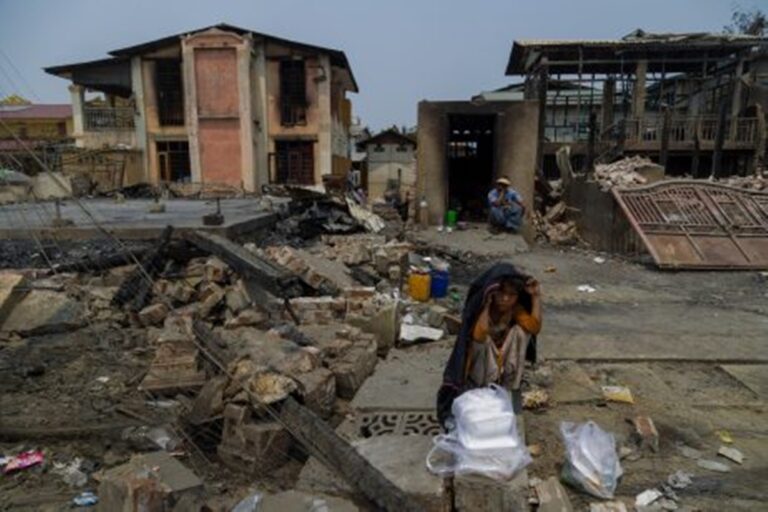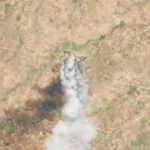
On April 18, Malaysian Prime Minister Anwar Ibrahim announced that he had met with Senior Gen. Min Aung Hlaing, the head of Myanmar’s military junta, to discuss the response to the powerful earthquake that hit central Myanmar in late March. He subsequently claimed that the junta had agreed to extend the ceasefire it announced on April 2, in order to facilitate aid and relief efforts. Last week, the military duly announced an extension of the ceasefire from April 22 until the end of the month.
Unsurprisingly, the regime has mostly failed to honor the agreement. Since the initial ceasefire declaration by the military, the Myanmar Air Force has carried out an estimated 120 airstrikes across different regions, including in earthquake-affected areas. Indeed, this is not the first time the junta has publicly committed to terms, such as the Association of Southeast Asian Nations (ASEAN)’s Five-Point Consensus peace plan, only to ignore them later. As such, ASEAN must look beyond the junta’s ceasefire announcements and assess the realities on the ground.
Merely achieving a generic ceasefire is not sufficient, especially in the context of Myanmar’s ongoing conflicts. Ceasefires have historically been used by armed groups as strategic tools to buy themselves time to regroup, redeploy, and gain a tactical advantage. In addition to airstrikes by the Myanmar Air Force, there have been reports of the military taking advantage of the current ceasefire for operational purposes, such as mobilizing troops along the strategic Sagaing-Monywa road and conducting operations in Mandalay Region. Likewise, on April 8, a coalition of resistance groups reportedly attacked Myanmar military soldiers stationed at a bunker along the Monywa–Mandalay road in earthquake-affected Myinmu township, claiming the assault was in retaliation for military airstrikes carried out during the ceasefire time.
Moreover, these ceasefires are often unilateral, lacking defined terms/conditions and any degree of enforceability. Rather than accepting the junta’s ceasefires at face value, ASEAN must push for clearly defined, multilateral ceasefire agreements with concrete conditions and robust monitoring systems. This is especially important given the current conflict dynamics, which are marked by fluid territorial control and unclear territorial boundaries, and make ceasefires even more difficult to hold.
Anwar told the media that aid would be delivered to affected communities regardless of who is in control of the territory. However, there are also structural issues within ASEAN as an institution that the bloc must overcome if any inclusive aid distribution is to take place. The bloc’s agreement on disaster response, which guides the operations of the ASEAN Coordinating Centre for Humanitarian Assistance on Disaster Management (AHA Center), mandates that overall management of aid be overseen by the receiving state party. It also requires that assisting member states respect the laws and regulations of the receiving state.
In practice, given ASEAN’s cooperation with the Myanmar military through the AHA Center in previous disaster efforts, the state party role will likely be allocated to the junta, effectively granting it oversight of earthquake response efforts. While aid should reach all affected communities regardless of their political affiliation, there is a real risk that the military will divert aid away from resistance-controlled areas while potentially using it to reward its support base, including Pyu Saw Htee militias active in the region. Moreover, compliance with state party regulations raises additional concerns, as aid operations are currently constrained by martial law, curfews, and requirements to report activities directly to the regime, which will further undermine the impartiality and effectiveness of humanitarian efforts.
Conversely, by centralizing aid distribution through the military regime, ASEAN will allow the military authorities to withhold aid from communities that are known to oppose its rule. Recent examples include the military’s blockade of aid to areas of Rakhine State occupied by resistance groups in the aftermath of Cyclone Mocha and Typhoon Yagi. Since the earthquake, communities in rural Sagaing Region, often perceived by the regime as sympathetic to the resistance, have so far received minimal official support, relying mostly on local initiatives and aid through informal channels.
To address these challenges, Malaysia must begin by rethinking ASEAN’s current humanitarian approach. The recent earthquake has made it even clearer that Myanmar no longer possesses a well-functioning central authority. The junta’s already limited capacity for effective aid distribution has been further exacerbated by the financial strain of post-earthquake reconstruction, including the destruction of most of the administrative buildings in the capital Naypyidaw, which could cost the regime up to $5 billion, as per the U.N. Development Programme’s estimate.
ASEAN must confront this reality and recognize that Myanmar, in its current state, functions only as a failed state. It must move beyond frameworks not designed for deeply unstable political environments, as previously noted by former AHA Center Executive Director Adelina Kamal, and ensure that engagement extends to all relevant stakeholders in the conflict.
Notably, Anwar also held a meeting with the National Unity Government (NUG) to discuss earthquake relief efforts. This outreach is a positive step, and the NUG, with its extensive network of People’s Administration Organizations on the ground, is a viable actor for disaster and humanitarian response in northern Sagaing Region, especially in rural areas. Yet challenges remain, including coordination with local defense forces (LDFs) not under NUG command for aid distribution in areas beyond the reach of NUG-aligned People’s Defense Forces (PDFs).
Sagaing is home to both PDFs and LDFs, which occasionally fight over territory or compete for resources. To streamline aid efforts and ensure safety for aid workers, the NUG, for its part, should bolster collaboration with local initiatives like the Sagaing Forum, a coalition of local civil society organizations and LDFs, which has recently formed an earthquake response team for Sagaing.
While the AHA Center’s guidelines are ill-suited to Myanmar’s current political realities, any amendment requires consensus among ASEAN member states, which remains infeasible due to differing political positions and interests within the bloc regarding Myanmar’s conflict. In this context, in order to reach earthquake-affected communities under resistance-held territories, Malaysia, as ASEAN chair, should explore alternative humanitarian aid pathways to the AHA Center.
Cross-border mechanisms facilitated by non-state actors should be considered viable channels for humanitarian aid delivery, as they offer greater flexibility and the ability to bypass routes controlled by the military regime. Observers such as David Scott Mathieson have noted that Chinese aid workers responding to the recent earthquake have accessed Sagaing via territories controlled by the Kachin Independence Organization (KIO). Channeling aid through the Kachin-Sagaing border could also circumvent the current logistical challenges. Observers have noted the issues with access to the Sagaing Region via Mandalay, with the old Sagaing bridge destroyed and the new one limited in capacity. The Kachin Independence Army, the KIO’s military wing, has already made territorial gains in northern Sagaing, with the important town of Indaw recently falling under its control, developments that could pave the way for future alternative aid routes into the central dry zone.
Finally, amid an era of regional diplomatic realignment and U.S.-China trade tensions, which has seen China turn increasingly to Southeast Asia for trade cooperation, Malaysia should leverage this momentum to strengthen collaboration with Beijing in addressing the Myanmar crisis, including exploring the potential to channel aid through the China–Myanmar border to reach hard-to-access areas in central Myanmar. China also has a vested interest in disaster response and infrastructure reconstruction, given that its China-Myanmar Economic Corridor projects run through earthquake-affected areas.
With the United States pulling back from its leading humanitarian role in Myanmar, ASEAN has an opportunity, as well as an urgent need, to step up and move beyond its current approaches. The growing risk of inflation, supply chain disruption from the recent earthquake, and prolonged conflict will only deepen suffering across Myanmar, making it ever more urgent for the bloc to establish aid mechanisms that extend beyond junta-controlled areas and move away from rigid, traditional guidelines that often do more harm than good.
Thank you for reading! Visit us anytime at Myanmar.com for more insights and updates about Myanmar
Related posts:
 Inle Lake Buddhist Festival in Myanmar | Tradition & Renewal
Inle Lake Buddhist Festival in Myanmar | Tradition & Renewal
 Thailand Extradites Shwe Kokko Tycoon She Zhijiang to China
Thailand Extradites Shwe Kokko Tycoon She Zhijiang to China
 Myanmar’s earthquake death toll rises to 3,770
Myanmar’s earthquake death toll rises to 3,770
 Myanmar Military Paraglider Strike Kills Dozens
Myanmar Military Paraglider Strike Kills Dozens
 UN: Over 400 Rohingya Feared Dead in Two Shipwrecks Off Myanmar Coast
UN: Over 400 Rohingya Feared Dead in Two Shipwrecks Off Myanmar Coast
 How Myanmar’s Gold Rush Puts International Rivers at Risk
How Myanmar’s Gold Rush Puts International Rivers at Risk
